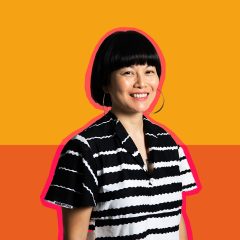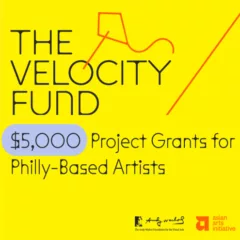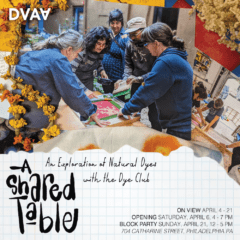Inscrutable is a two-venue show. This review focuses on the half of the show that is at the Asian Arts Initiative. A review of the half that is at the University of Delaware space at the Crane Arts Center will be reviewed, also today, in Roberta’s Weekly Update. Although the shows mostly have pieces that are different, there is some overlap.–r&l
Inscrutable, an exhibition happening concurrently at the Asian Arts Initiative and the University of Delaware at the Crane, explores issues facing Asian artists such as globalization and multiculturalism.
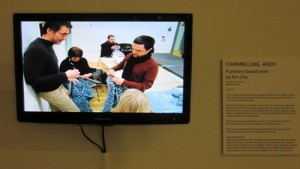
The first piece to the left of the doorway as visitors enter the Asian Arts Initiative is a digital slide show documenting a group project orchestrated by Ken Chu – “Channeling Andy: A process-based work.” The artist in his statement explains that he intentionally chose a skill that he did not know for his post-minimalist work, and that he wanted to reference the social network of Andy Warhol’s factory. Ken Chu assembled a group of knitters and together they recycled plastic bags by turning them into yarn, which would then become a material used in making his mixed-media paintings. The plastic yarn was knitted by the group into sleeves that fit over Chu’s rectangular, monochromatic paintings. The finished pieces are formally beautiful and show the endless possibilities organic forms have to offer.
Since the process of making the work is the focus of “Channeling Andy,” showing a slide show of the works in progress is very effective. The learning, encouragement, and sharing of ideas that went on during this project is made apparent to the viewers. However, it would be helpful to see one of the finished pieces next to the slide show in order to get a better understanding of how effective the pieces were in terms of materials and formal ideas, as well as the contrast between the texture of the plastic yarn and the smooth texture of the paint.
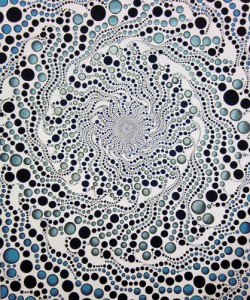
Barbara Takenaga’s “Black/White/Blue” is an acrylic painting that is 54″ x 45″ and covered in an intricate spiral pattern consisting of hundreds of circles that grow larger as the spiral reaches out towards the edges of the linen on which it is painted. The board was first given a white background. Blue, black, and red circles were painted on top, along with various lines that help to articulate the order of the spiral. Only a few small circles in a selected area are red and that made me wonder if there is a certain significance to these circles – perhaps the artist had a particular system she was following when it came to coloring the circles.
The immense size of the work completely surrounds viewers with the pattern and throws them off balance. This type of artwork allows the viewer to get an idea of the great amount of time and physical effort the artist put into the piece. Time and effort does not automatically make a work great – but the attention to detail, color choices, composition, and optical illusions that went into this piece make it very effective. It would be even better to see this work done in oil paint, since color plays such an important role here. The matte, plastic quality that acrylic paint has may not always work well for these intricate, abstract paintings.
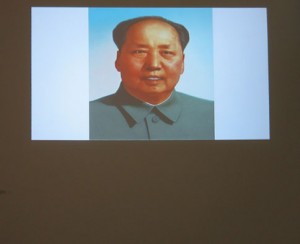
Also included in the show is a video art piece by Jinming Dong titled “I Want to Talk: 1956”. The video, which is in both venues, consists of a computer animated Chairman Mao giving a speech to the National Association of Music Workers and some other comrades in Beijing on August 24, 1956, which Dong translated to English. The projected video shows Mao, dressed in his traditional grey suit, from the shoulders up. The colors are vibrant, like those you would see in an animated film, as opposed to the colors of a film from 1956.
At the Asian Arts Initiative, this video is projected towards the top of the wall to give the feeling that the viewer is looking up at Chairman Mao. The piece puts the viewer in a subordinate position – he/she is below Mao and the image of Mao is larger then life. Since the artist chose to create an animated Chairman Mao instead of showing real footage of him, the piece made me think of George Orwell’s Big Brother.
Due to the nature of the exhibition, the artwork varies greatly. As such, it would be helpful to see the materials and sizes of the pieces included on their title cards. Nevertheless, the work is tied together by its connection to Asian culture. Some pieces reference Asian culture and stereotypes directly, while others use geometric forms or philosophical approaches that connect to the artists’ heritage. The part of the exhibition at the Asian Arts Initiative had some strong and engaging pieces, but felt sparse. Perhaps some of the works could have been eliminated so that they all fit in one location.
The Asian Arts Initiative, located at 1219 Vine Street, is more than a gallery space – it also puts on musical performances, theatrical performances, and workshops for all ages. The exhibition runs through February 26 with a closing reception occurring at the Asian Arts Initiative on Friday, February 4 from 5:30 – 7:30 pm.



